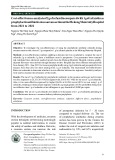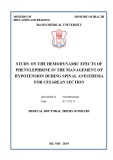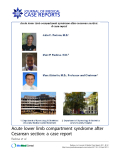
20
Journal of Medicine and Pharmacy, Volume 13, No.04, June-2023
Corresponding author: Truong Thi Linh Giang, email: ttlgiang@huemed-univ.edu.vn
Recieved: 24/8/2022; Accepted: 27/3/2023; Published: 10/6/2023
DOI: 10.34071/jmp.2023.4.3
Maternal and neonatal outcome in preterm premature rupture of
membranes
Truong Thi Linh Giang1*, Vo Quang Tan1
(1) Department of Obstetrics and Gynccology, Hue University of Medicine and Pharmacy,
Hue University, Vietnam
Abstract
Background: Preterm premature rupture of membranes is defined as rupture of membranes before the
onset of labor with the gestational age < 37 weeks. Preterm premature rupture of membranes is associated
with 10% of the perinatal mortality, particularly associated with respiratory distress syndrome and neonatal
infection. Objective: The study aims to assess the outcome of maternal and fetal outcome in preterm
premature rupture of membranes. Materials and Methods: This cross-sectional study was performed on
136 pregnant women complicated by preterm premature rupture of membranes during May 2020 to June
2022 at Hue University of Medicine and Pharmacy Hospital and Hue Central Hospital. The pregnant women
were managed to accord the current clinical practice of hospital. The information about objects is recorded
until the time of discharge. Results: The rate of vaginal delivery is 52.9% and intra-amniotic infection is
8.8%. The gestational age < 34 weeks and closed cervix are associated with a greater frequency of cesarean
section. The rate of neonatal infection is 34%, respiratory failure is 30%. The gestational age < 34 weeks and
prolonged duration of membrane rupture to delivery > 48 hours increase the risk of early neonatal infection
and neonatal respiratory failure, while the delivery methods are not increased these risks. Conclusion: Our
findings provide insights to physicians when counseling parents on preterm premature rupture of membranes
at periviable gestational age.
Keywords: preterm premature rupture of membranes, cesarean section, neonatal infection, neonatal
respiratory failure.
1. INTRODUCTION
Premature rupture of membranes (PROM) is a
rupture of the membranes (amniotic sac) before
labor begins. If PROM occurs before 37 weeks of
pregnancy, it is called preterm premature rupture of
membranes (PPROM) [1].
According to the data in 2018 at Hue University
of Medicine and Pharmarcy Hospital, the rate of
PPROM is about 16.4% [2]. According to American
College of Obstetricians and Gynecologists, preterm
birth occurs to approximately 10% of all births and
is a major contributor to perinatal morbidity and
mortality. PPROM complicates approximately 2-3%
of all pregnancies, whereas term PROM occurs
to approximately 8% of pregnancies. The rate of
PPROM < 27 weeks was 0.5%; 27 - 34 weeks was 1%
and 34 - 37 weeks was 1% [1, 3].
The gestational age, maternal risk, well-fetal
being are so important for management, prognostic
and counselling patient [1]. PPROM is accounted
for 10% perinatal mortality. The most significant
risks of the fetus after PPROM are complications
from prematurity including respiratory distress,
intraventricular hemorrhage, neonatal infection,
pulmonary hypoplasia. Overall, PPROM has been
reported to be associated with a fourfold increase
in perinatal mortality. Management and taking care
a preterm baby is costly. The incidence of retained
placenta, postpartum infection, cesarean section
caused by abnormal fetal presentation, umbilical
cord prolapse, amniotic infection are higher with
preterm women [4].
The optimal management of pregnancies
complicated by PPROM remains a challenge.
The most challenging scenarios the OB doctors
need to solve that is choosing whether expectant
management or induction of labor. Some researches
showed that early intervention can increase failed
induction to labor, but delayed induction can
increase the risk for maternal and fetal infection [5].
Royal College of Obstetricians and Gynaecologists
provides age-based management guidelines
between 24 and 37 weeks of pregnancy with careful
monitoring to achieve better outcomes for the
mother and her baby [6].
Although gestational age-based guidelines are
essential to health care providers in the maternal/
neonatal treatment decision-making, counselling

























